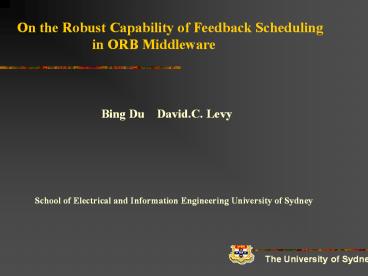On the Robust Capability of Feedback Scheduling in ORB Middleware
1 / 20
Title:
On the Robust Capability of Feedback Scheduling in ORB Middleware
Description:
School of Electrical and Information Engineering University of Sydney. The University of Sydney ... Two tank system model to emulate a scheduling system ... –
Number of Views:34
Avg rating:3.0/5.0
Title: On the Robust Capability of Feedback Scheduling in ORB Middleware
1
On the Robust Capability of Feedback Scheduling
in ORB Middleware
- Bing Du
David.C. Levy - School of Electrical and Information
Engineering University of Sydney
The University of Sydney
2
Outline of presentation
- Introduction.
- H8control scheduling Architecture.
- H8 robust controller and H8-NMPC controller.
- Overview of hORB Architecture
- Conclusion
3
Introduction
- Traditional scheduling are no longer promise the
function and performance requirements of DRE
systems. - The common ORB middleware scheduling approaches
cant provide real-time performance guarantees
because they depend on accurate task execution
times.
4
Introduction
- Many recent scheduling research approaches have
applied feedback control theory, but little
theoretical analysis has been provided about
effects of the plant uncertainty and nonlinearity
on the desired system performance. - H8-nonlinear model predictive control scheduling
(H8-NMPC) is provided an excellent theoretical
framework for dealing with nonlinear stability
and robustness issues by H8 theory.
5
H8 control scheduling Architecture
- Task model
U e / d r. - Requested CPU utilization U ,release time r ,
execution time e , deadline d - The performance can be interpreted as a
quality-of-service (QoS) measure. The system will
control the rate of deadline misses by regulating
the QoS of the task.
6
H8 control scheduling Architecture
7
H8 robust controller
- The physical process is a nonlinear model and can
be treated in continuous time, with continuous
signals, while the controller is a discrete time
algorithm - Tustin transform to transform continuous systems
into discrete systems and back again - S 2(z-1) / T(z1)
8
Generalized nonlinear discrete-time H8 system
P is an LTI system f(q) is a static
nonlinearity and ? is a block structured, norm
bounded perturbation
9
H8 robust controller
- Transfer function from w to e
- e Fl F u ( P ( s ), ? ), K ( s ) w G (
s ) w - satisfies a norm objective
- The problem is to design K(s) such that for all ?
? B?, K (s) stabilizes Fu(P(s), ?), and - F u ( F l( P (s), K (s) ), ? ? 1.
- This is equivalent to K (s) satisfying
- µ Fl ( P ( s ) K ( s ) )lt1
10
H8-NMPC controller
- Based on the derivation of a stationary
Hamilton-Jacobi-Isaacs equation, which is the
nonlinear analogous of the FHARE (fake H8
algebraic Riccati equation), it is shown that the
H8 NMPC control law is the solution of an
associated infinite horizon H8 control problem,
11
H8-NMPC controller
- a class of systems described by the following
nonlinear set of differential equations - (t) f ((t), u (t)), (0)
- where (t) and u (t) denotes the vector of
states and inputs, respectively.
12
H8-NMPC controller
- The finite horizon open-loop problem described
above is mathematically formulated as follows - find min J ((t), u () Tc, Tp)
- u ()
- with J ( x (t), u () Tc, Tp)
- where Tc and Tp denotes control horizon and
prediction horizon, and u () denotes the
internal input.
13
Generalized and weighted performance block
diagram
14
DK iteration
- The current approach to design a controller is
known as DK iteration . - Suppose that K(s) stabilizes P (s) and
- F(P (s) K(s)) ? 1
- This is an upper bound for the µ problem,
implying that, - µF(P (s) K(s)) 1
- The µsynthesis problem can be replaced with
the following approximation - inf DF(P (s) K(s))D?¹
- D? Ð
- K(s) stabilizing
15
Two tank system model to emulate a scheduling
system
- Design a controller that regulates the levels in
tank2, h2. - The task actuator controls the flow into the
system. The tasks that adds the height of liquid
tank 2 not higher than 100 cm can be admitted.
QoS actuator can adjust the tank 2 liquid higher
or lower so that the level keeps at 100 cm. The
deadlines of accepted tasks can be achieved by
EDF if the height of liquid tank 2 is below 100
cm.
16
Two tank system model of scheduling system
17
Tracking simulation
perturbed system with 10 change. The inputs
are constrained to remain within 25-75
18
Overview of hORB Architecture
- This framework is based on AMIDST 21 and
deploys the advanced control theory mechanisms to
provide deadline miss ratio and utilization
guarantees and to adapt execution environment to
variation in the resource availability. - The H8-NMPC/connection threads on the server are
connected with each client connection thread
through a TCP connection called feedback lane. - Each client receives the new QoS parameter for
its remote method invocation requests from
translator on the server through the feedback
lane.
19
hORB Architecture
20
Conclusion
- Our mechanism give a systematically and
theoretically platform to investigate how to deal
with uncertainty and additive disturbance for
real-time system and how to design a H8 control
scheduling. - The experimental results show that proposed
scheduler improves the robust stable performance
for uncertain real-time systems even when system
parameters and workload vary.































